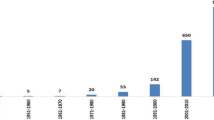Abstract
The aim of this project was to evaluate research groups working in the broad field of plant biomass in the areas outside the USA and the EC. The assessment had two key elements: the measurement of scientific productivity and the investigation of factors affecting research performance. Research groups were identified from a range of information sources. Data on funding, information access, staffing, publication policy and degree of awareness of other research groups in the field were collected during the course of interviews. Two approaches —bibliometric analysis and peer review — were examined as a means of constructing indicators for assessing research output.
Following a critical review of the use of bibliometric indicators in peripheral countries, the results from a study of eight countries are presented. Neither of two indicators employed proved to be a particularly successful method of evaluating research, and this finding is discussed in relation to publication patterns, the nature of the research community and the research field under study. Finally, the use of a “peripatetic expert” was found to have some value as a means of assessment.
Similar content being viewed by others
Notes and references
D.M. Hicks,Beyond Serendipity: Factors Affecting Research Performance in Condensed Matter Physics, D. Phil Thesis, University of Sussex, UK, 1989.
A.J. Nederhof, The validity and reliability of evaluation of scholarly performance. In:Handbook of Quantitative Studies of Science and Technology,A.F.J. Van Raan (Ed.), Elsevier Science Publishers B.V. (North Holland), 1988, p. 193.
J. Irvine, B.R. Martin, Assessing basic research: the case of the Isaac Newton telescope,Social Studies of Science, 13 (1983) 49–86.
H. Morita-Lou (Ed.),Science and Technology Indicators for Development, United Nations Science and Technology for Development Series, Westview Press, Boulder and London, 1985, p. 13.
For a review of 24 studies involving bibliometric and non-bibliometric indicators, seeF. Narin,Evaluative Bibliometrics: The Use of Publication and Citation Analysis in the Evaluation of Scientific Activity, Report in fulfillment of contract number NSF C-627, Computer Horizons Inc., Cherry Hill, New Jersey, US, 1976.
J. Irvine, B.R. Martin, Assessing basic research: some partial indicators of scientific progress in radio astronomy,Research Policy, 12 (1983) 61–90.
J. Irvine, B.R. Martin, CERN: Past performance and future prospects,Research Policy, 13 (1984) 247–284.
Op. cit. note 3, 49–86.
The Institute for Scientific Information (ISI) in Philadelphia scans 3500 of the world's leading scientific journals (ISI-recognized-journals) and publishes theSCI which contains citation data for papers referred to in ISI-recognized-journals.
M.J. Moravcsik,The Scientist, 11 (1987).
M.J. Moravcsik, Strengthening the Coverage of Third World Science. The final report of the Philadelphia workshop, July, 1988, p. 10.
S. Arunachalam, Citation Counts as Indicators of the Science and Technology Capacity of Third World Nations (mimeo). Paper presented at the Annual Meeting of the American Association for the Advancement of Science, 26–31, May, 1985, Los Angeles, US, 1985.
D. Hicks, B.R. Martin, J. Irvine, Bibliometric techniques for monitoring performance in technologically oriented research: the case of integrated optics,R & D Management, 16 (1986) 211–223.
V. Cano, F.E. Burke, Publication Patterns in Mexican Science (mimeo), 1986.
J.D. Frame, Measuring scientific activity in lesser developed countries,Scientometrics, 2 (1980) 133–135.
L. Velho, J. Krige, Publication and citation practices of Brazilian agricultural scientists,Social Studies of Science, 14 (1984) 45–62.
L. Velho, The meaning of citation in the context of a scientifically peripheral country,Scientometrics, 9 (1986) 71–89.
Op. cit. note 17 71–89.
C.M. Castro,Ciência e Universidade, Jorge Zahar Publ., Rio de Janeiro, 1985, p. 72.
F. Spagnolo, Brazilian scientists' publications and mainstream science: some policy implications,Scientometrics, 18 (1990) 205–218.
L. Velho, The author and the beholder: how paradigm commitments can influence the interpretation of research results,Scientometrics, 11 (1987) 59–70.
M.J. Moravcsik, In the beholder's eye: a possible reinterpretation of Velho's results on Brazilian agricultural research,Scientometrics, 11 (1987) 53–57.
Y. Yuthavong, Bibliometric indicators of scientific activity in Thailand,Scientometrics, 9 (1986) 139–143.
K.C. Garg, M.K.D. Rao Bibliometric analysis of scientific productivity: a case study of an Indian physics laboratory,Scientometrics, 13 (1988) 261–269.
F.W. Lancaster, M.A. Porta, K. Plagenz, K. Szymborski, M. Krebs, Factors influencing sources cited by scientists: a case study for Cuba,Scientometrics, 10 (1986) 243–257.
Y.M. Rabkin, H. Inhaber, Science on the periphery: a citation study of three less developed countries,Scientometrics, 1 (1979) 261–274.
Y.M. Rabkin, T.O. Eisemon, J.J. Lafitte-Hoossat, E. Mclean Rathgeber Citation visibility of Africa's science,Social Studies of Science, 9 (1979) 499–506.
S. Arunachalam, K.C. Garg, A small country in a world of big science,Scientometrics, 8 (1986) 301–313.
IMF, International Financial Statistics, XLII (4), Washington, US, 1988.
V. Cano, F.E. Burke, Publication Patterns in Mexican Science (mimeo), 1986.
Op. cit. note 15.
Op. cit. note 17 71–89.
C. H. Henderson, Personal communication.
C. De Moura Castro, F. Spagnolo, cited in:L. Velho, See note 17.
J.A. Large,The Foreign Language Barrier: Problems in Scientific Communication, Deutsch, London, UK, 1983, p. 35.
TERI is the Tata Energy Research Institute New Delhi, India.
Op. cit. note 17 71–89.
A. Schubert, W. Glänzel, T. Braun World flash on basic research: scientometric datafiles,Scientometrics, 16 (1989) 3–478.
Author information
Authors and Affiliations
Rights and permissions
About this article
Cite this article
Thomas, S.M. The evaluation of plant biomass research: A case study of the problems inherent in bibliometric indicators. Scientometrics 23, 149–167 (1992). https://doi.org/10.1007/BF02020920
Received:
Issue Date:
DOI: https://doi.org/10.1007/BF02020920




